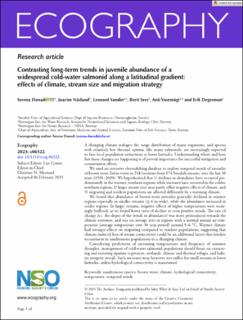| dc.description.abstract | A changing climate reshapes the range distribution of many organisms, and species with relatively low thermal optima, like many salmonids, are increasingly expected to face local population extinctions at lower latitudes. Understanding where and how fast these changes are happening is of pivotal importance for successful mitigation and conservation efforts. We used an extensive electrofishing database to explore temporal trends of juveniles of brown trout Salmo trutta in 218 locations from 174 Swedish streams, over the last 30 years (1991–2020). We hypothesized that 1) declines in abundance have occurred predominately in the warmer, southern regions, while increases have occurred in the colder, northern regions, 2) larger stream sizes may partly offset negative effects of climate, and 3) migrating and resident populations are affected differently by a warming climate. We found that abundance of brown trout juveniles generally declined in warmer regions especially in smaller streams (≤ 6 m wide), while the abundance increased in colder regions. In larger streams, negative effects of higher temperatures were seemingly buffered, as we found lower rates of decline or even positive trends. The rate of change (i.e. the slopes of the trends in abundance) was more pronounced towards the climate extremes, and was on average zero in regions with a normal annual air temperature (average temperature over 30 year period) around 5–6 °C. Warmer climate had stronger effects on migrating compared to resident populations, suggesting that climate-induced loss of stream connectivity could be an additional factor that hinders recruitment in anadromous populations in a changing climate. Considering predictions of increasing temperatures and frequency of summer droughts, management of cold-water salmonid populations should focus on conserving and restoring riparian vegetation, wetlands, climate and thermal refugia, and habitat integrity overall. Such measures may, however, not suffice for small streams at lower latitudes, unless hydrological connectivity is maintained. | en_US |

